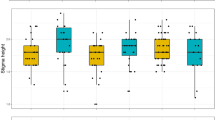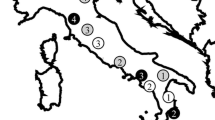Abstract
In sexually deceptive orchids, pollinator specificity is the main factor responsible for species isolation. The two sexually deceptive orchids Ophrys chestermanii and Ophrys normanii occur sympatrically on Sardinia and attract the same pollinator, males of Bombus vestalis, by producing the same odour bouquets. Since gene flow between these two species has been shown to be almost absent, their genetic distinctness seems to be preserved by other forms of reproductive barrier than pollinator specificity. The aim of this study is to investigate the nature and strength of these isolation barriers which apparently halt gene flow between these two orchids that share the same pollinator. Morphological measurements, combined with observations of cross-pseudocopulations, revealed that, in sympatry, the longer caudicles of O. normanii and the smaller and differently shaped stigmatic cavity in O. chestermanii are the main factors preventing gene flow between these two sympatric species. In contrast, other pre- or post-mating barriers seem to be weak or absent, as the two species have overlapping flowering time and we were able to rear hybrid offspring from interspecific manual crosses. At the same time, genetic analysis of orchid plantlets collected at sympatric sites detected the presence of only two putative hybrid individuals. Thus, the probability of natural cross-pollination between O. normanii and O. chestermanii seems to be strongly limited by divergence in their floral morphology. For some traits, this divergence was found increased between sympatric populations.



Similar content being viewed by others
References
Aceto S, Caputo P, Cozzolino S, Gaudio L, Moretti A (1999) Phylogeny and evolution of Orchis and allied genera based on ITS DNA variation: morphological gaps and molecular continuity. Mol Phylogenetic Evol 13:67–76
Agren L, Kullenberg B, Sensenbaugh T (1984) Congruences in pilosity between 3 species of Ophrys Orchidaceae and their hymenopteran pollinators. Nova acta Regiae Societatis Scientiarum Upsaliensis Ser. V C 3:15–25
Ascensao L, Francisco A, Cotrim H, Pais MS (2005) Comparative structure of the labellum in Ophrys fusca and O. lutea (Orchidaceae). Am J Bot 92:1059–1067
Ayasse M (2006) Floral scent and pollinator attraction in sexually deceptive orchids. In: Dudareva N, Pickersky E (eds) Biology of floral scent. CRC Press, Boca Raton, pp 219–241
Ayasse M, Schiestl FP, Paulus HF, Löfstedt C, Hansson B, Ibarra F, Francke W (2000) Evolution of reproductive strategies in the sexually deceptive orchid Ophrys sphegodes: how does flower-specific variation of odor signals influence reproductive success? Evolution 54:1995–2006
Ayasse M, Schiestl FP, Paulus HF, Ibarra F, Francke W (2003) Pollinator attraction in a sexually deceptive orchid by means of unconventional chemicals. Proc R Soc B Biol Sci 270:517–522
Ayasse M, Stökl J, Francke W (2011) Chemical ecology and speciation in sexually deceptive orchids. Phytochemistry 72:1667–1677
Beyrle H, Penningsfeld F, Hock B (1989) Mykorrhiza-Synthese in gärtnerischen Kultursubstraten und in natürlichen Böden. Die Orchidee 4:173–177
Borg-Karlson AK (1990) Chemical and ethological studies of pollination in the genus Ophrys (Orchidaceae). Phytochemistry 29:1359–1387
Breitkopf H, Onstein RE, Cafasso D, Schlüter PM, Cozzolino S (2014) Multiple shifts to different pollinators fuelled rapid diversification in sexually deceptive Ophrys orchids. New Phytol. doi:10.1111/nph.13219
Cafasso D, Widmer A, Cozzolino S (2005) Chloroplast DNA inheritance in the orchid Anacamptis palustris using single-seed polymerase chain reaction. J Hered 96:66–70
Cortis P, Vereecken NJ, Schiestl FP, Lumaga MRB, Scrugli A, Cozzolino S (2009) Pollinator convergence and the nature of species boundaries in sympatric Sardinian Ophrys (Orchidaceae). Ann Bot 104:497–506
Coyne JA, Orr HA (2004) Speciation. Sinauer Associates, Sunderland
Cozzolino S, Scopece G (2008) Specificity in pollination and consequences for post-mating reproductive isolation in deceptive Mediterranean orchids. Philos Trans R Soc B 363:3037–3046
Delforge P (2006) Orchids of Europe, North Africa and the Middle East. A&C Black, London
Doyle JJ, Doyle JL (1987) A rapid DNA isolation procedure for small quantities of fresh leaf tissue. Phytochem Bull 19:11–15
Ehrendorfer F (1980) Hybridisierung, Polyploidie und Evolution bei europäisch-mediterranen Orchideen. Die Orchidee Sonderheft 33:15–34
Gill DE (1989) Fruiting failure, pollination inefficiency, and speciation in orchids. In: Otte D, Endler JA (eds) Speciation and its consequences. Academy of Natural Science Publications, Philadelphia, pp 458–481
Gögler J, Stökl J, Sramkova A, Twele R, Francke W, Cozzolino S, Cortis P, Scrugli A, Ayasse M (2009) Ménage à trois—two endemic species of deceptive orchids and one pollinator. Evolution 63:2222–2234
Grant V (1971) Plant speciation. Columbia University Press, New York
Grant V (1994) Modes and origins of mechanical and ethological isolation in angiosperms. Proc Natl Acad Sci 91:3–10
Harrison RG (1993) Hybrid zones—natural laboratories for evolutionary studies. Trends Ecol Evol 3:158–167
Hopkins R (2013) Reinforcement in plants. New Phytol 197:1013–1095
Hopkins R, Rausher MD (2012) Pollinator-mediated selection on flower color allele drives reinforcement. Science 335:1090–1092
Huang SQ, Shi XQ (2013) Floral isolation in Pedicularis: How do congeners with shared pollinators minimize reproductive interference? New Phytol 199:858–865
Kullenberg B (1961) Studies in Ophrys pollination. Zoologiska bidrag fran Uppsala 34:1–340
Levin DA (1985) Reproductive character displacement in Phlox. Evolution 39:1275–1281
Levin DA, Anderson WW (1970) Competition for pollinators between simultaneously flowering species. Am Nat 104:455–467
Martin NH, Willis JH (2007) Ecological divergence associated with mating system causes nearly complete reproductive isolation between sympatric Mimulus species. Evolution 61:68–82
Norton NA, Fernando MTR, Herlihy CR, Busch JW (2015) Reproductive character displacement shapes a spatially structured petal color polymorphism in Leavenworthia stylosa. Evolution. doi:10.1111/evo.12659
Paulus HF, Gack C (1990) Pollinators as prepollinating isolation factors: evolution and speciation in Ophrys (Orchidaceae). Isr J Bot 39:43–79
Pauw A (2013) Can pollination niches facilitate plant coexistence? Trends Ecol Evol 28:30–37
Rieseberg LH (2001) Chromosomal rearrangements and speciation. Trends Ecol Evol 16:351–358
Schemske DW (2000) Understanding the origin of species. Evolution 54:1069–1073
Schiestl FP (2005) On the success of a swindle: pollination by deception in orchids. Naturwissenschaften 92:255–264
Schiestl FP, Ayasse M (2000) Post-mating odor in females of the solitary bee, Andrena nigroaenea (Apoidea, Andrenidae), inhibits male mating behavior. Behav Ecol Sociobiol 48:303–307
Schiestl FP, Ayasse M (2002) Do changes in floral odor cause speciation in sexually deceptive orchids? Plant Syst Evol 234:111–119
Schiestl FP, Ayasse M, Paulus HF, Löfstedt C, Hansson BS, Ibarra F, Francke W (1999) Orchid pollination by sexual swindle. Nature 399:421–422
Scopece G, Musacchio A, Widmer A, Cozzolino S (2007) Patterns of reproductive isolation in Mediterranean deceptive orchids. Evolution 61:2623–2642
Scopece G, Widmer A, Cozzolino S (2008) Evolution of postzygotic reproductive isolation in a guild of deceptive orchids. Am Nat 171:315–326
Slatkin M (1980) Ecological character displacement. Ecology 61:163–177
Smith RA, Rausher MD (2008) Selection for character displacement is constrained by the genetic architecture of floral traits in the ivyleaf morning glory. Evolution 62:2829–2841
Stebbins GL (1971) Chromosomal evolution in higher plants. Edward Arnold, London
Stebbins GL, Ferlan L (1956) Population variability, hybridization introgression in some species of Ophrys. Evolution 10:32–46
Stökl J, Paulus H, Dafni A, Schulz C, Francke W, Ayasse M (2005) Pollinator attracting odour signals in sexually deceptive orchids of the Ophrys fusca group. Plant Syst Evol 254:105–120
Stökl J, Twele R, Erdmann DH, Francke W, Ayasse M (2007) Comparison of the flower scent of the sexually deceptive orchid Ophrys iricolor and the female sex pheromone of its pollinator Andrena morio. Chemoecology 17:231–233
Stökl J, Schlüter PM, Stuessy TF, Paulus HF, Assum G, Ayasse M (2008) Scent variation and hybridization cause the displacement of a sexually deceptive orchid species. Am J Bot 95:472–481
Tremblay RL, Ackerman JD, Zimmerman JK, Calvo RN (2005) Variation in sexual reproduction in orchids and its evolutionary consequences: a spasmodic journey to diversification. Biol J Linn Soc Lond 84:1–54
van der Niet T, Johnson SD (2012) Phylogenetic evidence for pollinator-driven diversification of angiosperms. Trends Ecol Evol 27:353–361
Vereecken NJ, Cozzolino S, Schiestl FP (2010) Hybrid floral novelty drives pollinator shift in sexually deceptive orchids. BMC Evol Biol 10:103
Warcup JH (1973) Symbiotic germination of some Australian terrestrial orchids. New Phytol 72:387–392
Whitehead MR, Peakall R (2014) Pollinator specificity drives strong prepollination reproductive isolation in sympatric sexually deceptive orchids. Evolution 68:1561–1575
Xu S, Schlüter PM, Scopece G, Breitkopf H, Gross K, Cozzolino S, Schiestl FP (2011) Floral isolation is the main reproductive barrier among closely related sexually deceptive orchids. Evolution 65:2606–2620
Xu S, Schlüter PM, Schiestl FP (2012) Pollinator-driven speciation in sexually deceptive orchids. Int J Ecol 285081:9
Acknowledgments
We thank Claudia Gack, Manfred Kalteisen, Cesario Giotta and Marcello Piccitto for helping us to collect plant material and Hannes Paulus, Hannah Burger and Heiko Bellmann for their help in producing figures. Financial support by the German Science Foundation (AY12/1-1, AY12/1-2) and the FAZIT-Stiftung is gratefully acknowledged.
Author information
Authors and Affiliations
Corresponding author
Electronic supplementary material
Below is the link to the electronic supplementary material.
Supplementary video 1: B. vestalis male, carrying pollinaria of O. normanii, pseudocopulating with a flower of O. chestermanii. It could be noted that the O. normanii pollinaria do not fit into the small stigmatic cavity of O. chestermanii. (WMV 1069 kb)
Supplementary video 2: B. vestalis male, carrying pollinaria of O. normanii, pseudocopulating with a flower of O. normanii. It could be noted that the O. normanii pollinaria well fit into the large stigmatic cavity of O. normanii. (WMV 1588 kb)
10682_2015_9779_MOESM3_ESM.tif
Supplementary Fig. 1: SEM images of stigmatic cavity of O. normanii (left) and O. chestermanii (right) (bar = 1 mm). (TIFF 4522 kb)
10682_2015_9779_MOESM4_ESM.tif
Supplementary Fig. 2: Frontal details of stigmatic cavities of flowers from three individuals of allopatric O. normanii (a–c), sympatric O. normanii (d–f), sympatric O. chestermanii (g–i), close allopatric O. chestermanii (j–l) and far allopatric O. chestermanii (m–o). (TIFF 15209 kb)
Rights and permissions
About this article
Cite this article
Gögler, J., Stökl, J., Cortis, P. et al. Increased divergence in floral morphology strongly reduces gene flow in sympatric sexually deceptive orchids with the same pollinator. Evol Ecol 29, 703–717 (2015). https://doi.org/10.1007/s10682-015-9779-2
Received:
Accepted:
Published:
Issue Date:
DOI: https://doi.org/10.1007/s10682-015-9779-2




